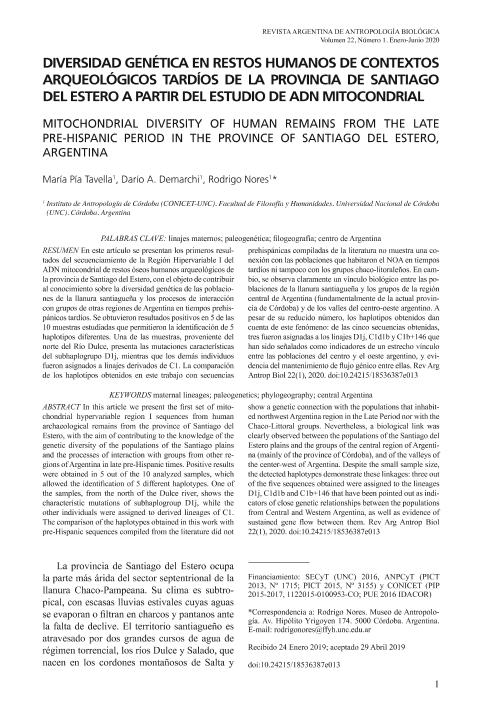Artículo
En este artículo se presentan los primeros resultados del secuenciamiento de la Región Hipervariable I del ADN mitocondrial de restos óseos humanos arqueológicos de la provincia de Santiago del Estero, con el objeto de contribuir al conocimiento sobre la diversidad genética de las poblaciones de la llanura santiagueña y los procesos de interacción con grupos de otras regiones de Argentina en tiempos prehispánicos tardíos. Se obtuvieron resultados positivos en 5 de las 10 muestras estudiadas que permitieron la identificación de 5 haplotipos diferentes. Una de las muestras, proveniente del norte del Río Dulce, presenta las mutaciones características del subhaplogrupo D1j, mientras que los demás individuos fueron asignados a linajes derivados de C1. La comparación de los haplotipos obtenidos en este trabajo con secuencias prehispánicas compiladas de la literatura no muestra una conexión con las poblaciones que habitaron el NOA en tiempos tardíos ni tampoco con los grupos chaco-litoraleños. En cambio, se observa claramente un vínculo biológico entre las poblaciones de la llanura santiagueña y los grupos de la región central de Argentina (fundamentalmente de la actual provincia de Córdoba) y de los valles del centro-oeste argentino. A pesar de su reducido número, los haplotipos obtenidos dan cuenta de este fenómeno: de las cinco secuencias obtenidas, tres fueron asignadas a los linajes D1j, C1d1b y C1b+146 que han sido señalados como indicadores de un estrecho vínculo entre las poblaciones del centro y el oeste argentino, y evidencia del mantenimiento de flujo génico entre ellas. In this article we present the first set of mitochondrial hypervariable region I sequences from human archaeological remains from the province of Santiago del Estero, with the aim of contributing to the knowledge of the genetic diversity of the populations of the Santiago plains and the processes of interaction with groups from other regions of Argentina in late pre-Hispanic times. Positive results were obtained in 5 out of the 10 analyzed samples, which allowed the identification of 5 different haplotypes. One of the samples, from the north of the Dulce river, shows the characteristic mutations of subhaplogroup D1j, while the other individuals were assigned to derived lineages of C1. The comparison of the haplotypes obtained in this work with pre-Hispanic sequences compiled from the literature did not show a genetic connection with the populations that inhabited northwest Argentina region in the Late Period nor with the
Chaco-Littoral groups. Nevertheless, a biological link was clearly observed between the populations of the Santiago del Estero plains and the groups of the central region of Argentina (mainly of the province of Córdoba), and of the valleys of the center-west of Argentina. Despite the small sample size, the detected haplotypes demonstrate these linkages: three out of the five sequences obtained were assigned to the lineages
D1j, C1d1b and C1b+146 that have been pointed out as indicators of close genetic relationships between the populations from Central and Western Argentina, as well as evidence of sustained gene flow between them.
Diversidad genética en restos humanos de contextos arqueológicos tardíos de la provincia de Santiago del Estero a partir del estudio de ADN mitocondrial
Título:
Mitochondrial diversity of human remains from the late pre-hispanic period in the province of Santiago del Estero, Argentina
Fecha de publicación:
01/2020
Editorial:
Universidad Nacional de La Plata
Revista:
Revista Argentina de Antropología Biológica
ISSN:
1514-7991
e-ISSN:
1853-6387
Idioma:
Español
Tipo de recurso:
Artículo publicado
Clasificación temática:
Resumen
Palabras clave:
LINAJES MATERNOS
,
PALEOGENÉTICA
,
FILOGEOGRAFÍA
,
CENTRO DE ARGENTINA
Archivos asociados
Licencia
Identificadores
Colecciones
Articulos(IDACOR)
Articulos de INSTITUTO DE ANTROPOLOGIA DE CORDOBA
Articulos de INSTITUTO DE ANTROPOLOGIA DE CORDOBA
Citación
Tavella, María Pía; Demarchi, Dario; Nores, Rodrigo; Diversidad genética en restos humanos de contextos arqueológicos tardíos de la provincia de Santiago del Estero a partir del estudio de ADN mitocondrial; Universidad Nacional de La Plata; Revista Argentina de Antropología Biológica; 22; 1; 1-2020; 1-14
Compartir
Altmétricas




